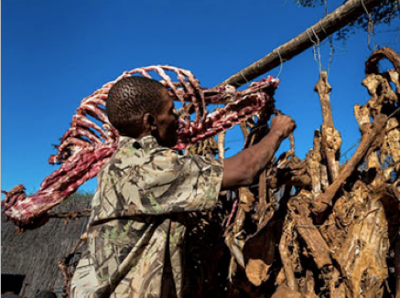|

Hanging lions out to dry…
Following from a decision at the most recent CITES Conference of Parties that allowed South African lion captive breeders to continue to trade in lion bones, a stakeholder meeting was organized yesterday by the SA Department of Environmental Affairs to begin the required submission of a trade quota.
Present at the meeting were representatives of the captive lion breeding industry, trophy hunters, bone traders in favour of the trade and conservationists urging caution.
While no decisions can be made until there has been an opportunity for further representations, and while a proposed trade quota of lion bones will probably not be put to CITES for their consideration until February 2, a worrying trend is already emerging.
The South African National Biodiversity Institute proposed a total of 800 lion skeletons on export quota per year EVEN BEFORE THE MEETING, and while this is far from being an accepted quota it shows the continued “appetite” of South Africa to continue to engage in the lion bone trade.
The lion bone trade from South Africa is conducted almost entirely with Laos and Vietnam. CITES trade records show that while there was no bone trade before 2008, the quantity of items in this trade has increased dramatically. During the five years 2010-2014 South Africa exported 1,555 kg of bones, 2,886 individual bones and 3,018 skeletons to Laos and Vietnam. The totals were most likely higher as evidence has come to light that such exports are frequently under-reported. These sorts of numbers indicate that the proposed quota is not much higher than the existing volume of exports.
However, it is important to consider the source of this proposed export. In the past, such bones were largely provided as by-products from trophy hunting of captive bred lions. While such hunting provided many carcasses (an average of 862 per annum from 2006-2014), recent changes in legislation and increased global public condemnation indicate that there will be a significant reduction in such trophy hunts in the future. For example, Australia, France, the Netherlands and most recently the USA have announced bans on the imports of such captive bred lion trophies, meaning that there will be an anticipated decline of about 58% in numbers of trophy hunters. By extension, that would suggest that only about 360 lions at maximum will be hunted in the future assuming that hunters from other nations will continue to hunt captive bred lions at current rates. Meaning that the proposed export of bones from 800 lion carcasses will have a shortfall of 440 lions annually.
Unless of course the lion breeders are now proposing to breed lions specifically for their bones? To supply a demand for products without any recognized “traditional medicine” value in Laos, Vietnam and China, more often consumed as a luxury product (bone wine)? Mark Jones, Associate Director at Born Free, also expressed concern that bones from hunted or poached wild lions and other endangered big cats will be laundered into trade.
We strongly advise South Africa to take a step back from this proposed trade and indeed to begin phasing out the entire captive breeding of lions for any product. As South African Tourism Minister Derek Hanekom mentioned, the sordid practice has already damaged “Brand South Africa”, and for those involved to seek to further expand the industry will surely result in even higher levels of global condemnation.
Loraine Liebenberg, Save our Rhino; Pieter Kat and Chris Macsween, LionAid
Picture credit Brent Stirton
|




